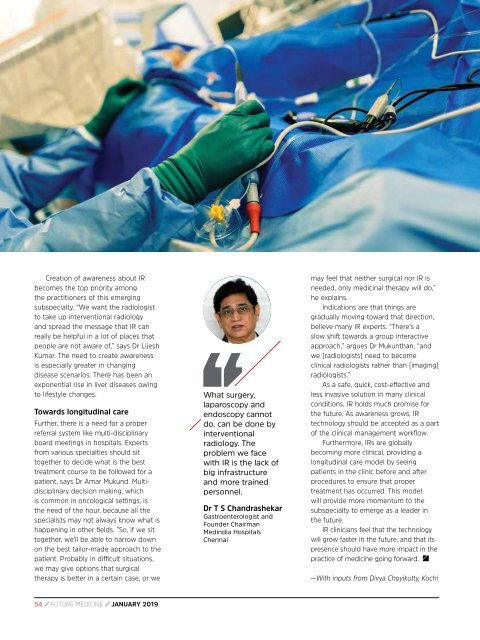FM JANUARY 2019 - digital edition
You also want an ePaper? Increase the reach of your titles
YUMPU automatically turns print PDFs into web optimized ePapers that Google loves.
slug<br />
Creation of awareness about IR<br />
becomes the top priority among<br />
the practitioners of this emerging<br />
subspecialty. “We want the radiologist<br />
to take up interventional radiology<br />
and spread the message that IR can<br />
really be helpful in a lot of places that<br />
people are not aware of,” says Dr Lijesh<br />
Kumar. The need to create awareness<br />
is especially greater in changing<br />
disease scenarios. There has been an<br />
exponential rise in liver diseases owing<br />
to lifestyle changes.<br />
Towards longitudinal care<br />
Further, there is a need for a proper<br />
referral system like multi-disciplinary<br />
board meetings in hospitals. Experts<br />
from various specialties should sit<br />
together to decide what is the best<br />
treatment course to be followed for a<br />
patient, says Dr Amar Mukund. Multidisciplinary<br />
decision making, which<br />
is common in oncological settings, is<br />
the need of the hour, because all the<br />
specialists may not always know what is<br />
happening in other fields. ”So, if we sit<br />
together, we’ll be able to narrow down<br />
on the best tailor-made approach to the<br />
patient. Probably in difficult situations,<br />
we may give options that surgical<br />
therapy is better in a certain case, or we<br />
What surgery,<br />
laparoscopy and<br />
endoscopy cannot<br />
do, can be done by<br />
interventional<br />
radiology. The<br />
problem we face<br />
with IR is the lack of<br />
big infrastructure<br />
and more trained<br />
personnel.<br />
Dr T S Chandrashekar<br />
Gastroenterologist and<br />
Founder Chairman<br />
Medindia Hospitals<br />
Chennai<br />
may feel that neither surgical nor IR is<br />
needed, only medicinal therapy will do,”<br />
he explains.<br />
Indications are that things are<br />
gradually moving toward that direction,<br />
believe many IR experts. “There’s a<br />
slow shift towards a group interactive<br />
approach,” argues Dr Mukunthan, “and<br />
we [radiologists] need to become<br />
clinical radiologists rather than [imaging]<br />
radiologists.”<br />
As a safe, quick, cost-effective and<br />
less invasive solution in many clinical<br />
conditions, IR holds much promise for<br />
the future. As awareness grows, IR<br />
technology should be accepted as a part<br />
of the clinical management workflow.<br />
Furthermore, IRs are globally<br />
becoming more clinical, providing a<br />
longitudinal care model by seeing<br />
patients in the clinic before and after<br />
procedures to ensure that proper<br />
treatment has occurred. This model<br />
will provide more momentum to the<br />
subspecialty to emerge as a leader in<br />
the future.<br />
IR clinicians feel that the technology<br />
will grow faster in the future, and that its<br />
presence should have more impact in the<br />
practice of medicine going forward.<br />
—With inputs from Divya Choyikutty, Kochi<br />
54 / FUTURE MEDICINE / <strong>JANUARY</strong> <strong>2019</strong>


















